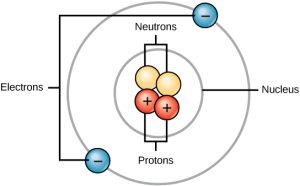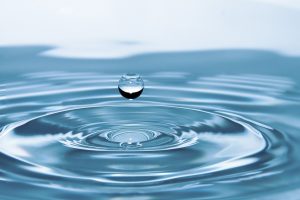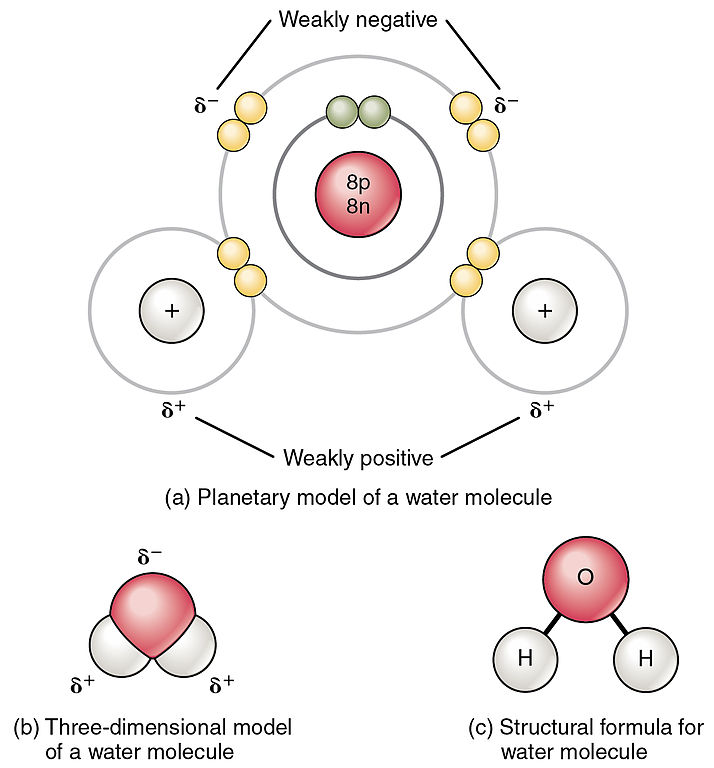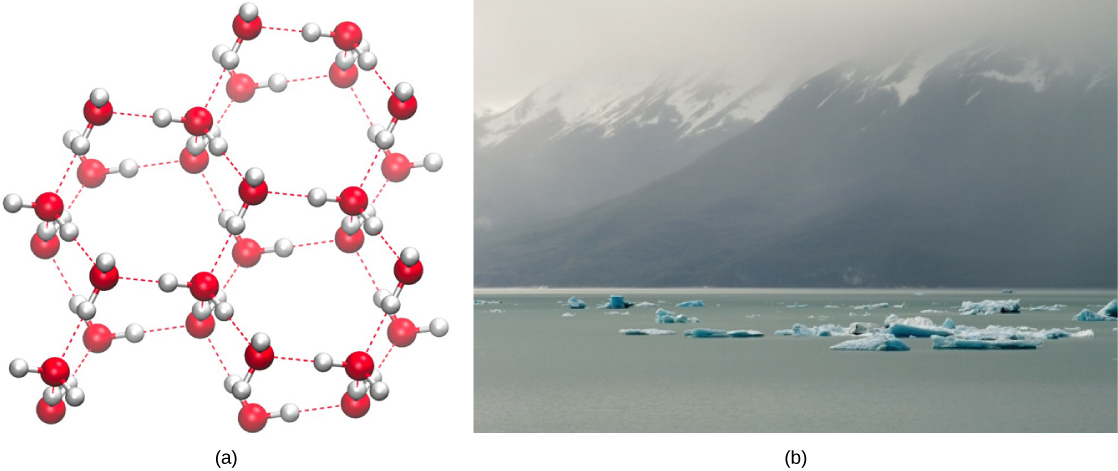Appendix C: Chemistry for Nutrition
Lisa Bartee and Jack Brook
Living things are highly organized and structured, following a hierarchy that can be examined on a scale from small to large. The examination of the smallest parts involves a knowledge of chemistry. We discussed the levels of organization of living things in the last chapter. In this chapter, we will learn some basic chemistry that is important in order to understand how molecules in cells function.[1]
ATOMS
An atom is the smallest component of an element that retains all of the chemical properties of that element. For example, one hydrogen atom has all of the properties of the element hydrogen, such as it exists as a gas at room temperature, and it bonds with oxygen to create a water molecule. Hydrogen atoms cannot be broken down into anything smaller while still retaining the properties of hydrogen. If a hydrogen atom were broken down into subatomic particles, it would no longer have the properties of hydrogen.
All atoms contain protons, electrons, and neutrons (Figure C.1). The only exception is hydrogen (H), which is made of one proton and one electron. A proton is a positively charged particle that resides in the nucleus (the core of the atom) of an atom. An electron is a negatively charged particle that travels in the space around the nucleus. In other words, it resides outside of the nucleus. Neutrons, like protons, reside in the nucleus of an atom. The positive (protons) and negative (electrons) charges balance each other in a neutral atom, which has a net zero charge.

At the most basic level, all organisms are made of a combination of atoms. They contain atoms that combine together to form molecules. In multicellular organisms, such as animals, molecules can interact to form cells that combine to form tissues, which make up organs. These combinations continue until entire multicellular organisms are formed.
Each element has its own unique properties. An element is a substance whose atoms all have the same number of protons. Different elements have different melting and boiling points, and are in different states (liquid, solid, or gas) at room temperature. They also combine in different ways. Some form specific types of bonds, whereas others do not. How they combine is based on the number of electrons present. Because of these characteristics, the elements are arranged into the periodic table of elements, a chart of the elements that includes the atomic number and relative atomic mass of each element. The periodic table also provides key information about the properties of elements (Figure C.2) —often indicated by color-coding. The arrangement of the table also shows how the electrons in each element are organized and provides important details about how atoms will react with each other to form molecules.
Isotopes are different forms of the same element that have the same number of protons, but a different number of neutrons. Some elements, such as carbon, potassium, and uranium, have naturally occurring isotopes. Carbon-12, the most common isotope of carbon, contains six protons and six neutrons. Carbon-14 contains six protons and eight neutrons. These two alternate forms of carbon are isotopes. Some isotopes are very stable. Other isotopes are unstable and will lose protons, other subatomic particles, or energy to form more stable elements. These unstable isotopes are called radioactive isotopes or radioisotopes.

CHEMICAL BONDS
Atoms can form several types of chemical bonds. These bonds are interactions between two atoms that hold the atoms together. It is important to understand the various types of bonds because they help determine how different molecules function within an organism. There are four types of bonds or interactions: covalent, ionic, hydrogen bonds, and van der Waals interactions.
Covalent Bonds
Another type of strong chemical bond between two or more atoms is a covalent bond. These bonds form when an electron is shared between two elements. Covalent bonds are the strongest and most common form of chemical bond in living organisms.
The hydrogen and oxygen atoms that combine to form water molecules are bound together by strong covalent bonds. The electron from the hydrogen atom shares its time between the hydrogen atom and the oxygen atom. In order for the oxygen atom to be stable, two electrons from two hydrogen atoms are needed, hence the subscript “2” in H2O. H2O means that there are 2 hydrogen atoms bonded to 1 oxygen atom (the 1 is implied below the O in the chemical formula). This sharing makes both the hydrogen and oxygen atoms more chemically stable.
There are two types of covalent bonds: polar and nonpolar (Figure C.3). Nonpolar covalent bonds form between two atoms that share the electrons equally so there is no overall charge on the molecule. For example, an oxygen atom can bond with another oxygen atom. This association is nonpolar because the electrons will be equally shared between each oxygen atom. Another example of a nonpolar covalent bond is found in the methane (CH4) molecule. The carbon atom shares electrons with four hydrogen atoms. The carbon and hydrogen atoms all share the electrons equally, creating four nonpolar covalent bonds (Figure C.3).
In a polar covalent bond, the electrons shared by the atoms spend more time closer to one atom than to the other. Because of the unequal distribution of electrons between the atoms, a slightly positive (δ+) or slightly negative (δ–) charge develops. The covalent bonds between hydrogen and oxygen atoms in water are polar covalent bonds. The shared electrons spend more time near the oxygen than they spend near the hydrogen. This means that the oxygen has a small negative charge while the hydrogens have a small positive charge.

Ionic Bonds
Atoms normally have an equal number of protons (positive charge) and electrons (negative charge). This means that atoms are normally uncharged because the number of positively charged particles equals the number of negatively charged particles. When an atom does not contain equal numbers of protons and electrons, it will have a net charge. An atom with a net charge is called an ion. Positive ions are formed by losing electrons. Negative ions are formed by gaining electrons. Atoms can lose and donate electrons in order to become more stable.

When an element donates an electron from its outer shell, as in the sodium atom example above, a positive ion is formed (Figure C.5). The element accepting the electron is now negatively charged. Because positive and negative charges attract, these ions stay together and form an ionic bond, or a bond between ions. The elements bond together with the electron from one element staying predominantly with the other element. When Na and Cl combine to produce NaCl, an electron from a sodium atom goes to stay with the other seven electrons in the chlorine atom, forming a positively charged sodium ion and a negatively charged chlorine ion. The sodium and chloride ions attract each other.

Hydrogen Bonds
Ionic and covalent bonds are strong bonds that require considerable energy to break. However, not all bonds between elements are ionic or covalent bonds. Weaker bonds can also form. These are attractions that occur between positive and negative charges that do not require much energy to break. Two weak bonds that occur frequently are hydrogen bonds and van der Waals interactions. These bonds give rise to the unique properties of water and the unique structures of DNA and proteins.
When polar covalent bonds containing a hydrogen atom form, the hydrogen atom in that bond has a slightly positive charge. This is because the shared electron is pulled more strongly toward the other element and away from the hydrogen nucleus. Because the hydrogen atom is slightly positive (δ+), it will be attracted to neighboring negative partial charges (δ–). When this happens, a weak interaction occurs between the δ+ charge of the hydrogen atom of one molecule and the δ– charge of the other molecule. This interaction is called a hydrogen bond. This type of bond is common; for example, the liquid nature of water is caused by the hydrogen bonds between water molecules (Figure C.6). Hydrogen bonds give water the unique properties that sustain life. If it were not for hydrogen bonding, water would be a gas rather than a liquid at room temperature.

Hydrogen bonds can form between different molecules and they do not always have to include a water molecule. Hydrogen atoms in polar bonds within any molecule can form bonds with other adjacent molecules. For example, hydrogen bonds hold together two long strands of DNA to give the DNA molecule its characteristic double-stranded structure. Hydrogen bonds are also responsible for some of the three-dimensional structure of proteins.
van der Waals Interactions
Like hydrogen bonds, van der Waals interactions are weak attractions or interactions between molecules. They occur between polar, covalently bound, atoms in different molecules. Some of these weak attractions are caused by temporary partial charges formed when electrons move around a nucleus. These weak interactions between molecules are important in biological systems.
WATER

Do you ever wonder why scientists spend time looking for water on other planets? It is because water is essential to life; even minute traces of it on another planet can indicate that life could or did exist on that planet. Water is one of the more abundant molecules in living cells and the one most critical to life as we know it. Approximately 60–70 percent of your body is made up of water. Without it, life simply would not exist.
Water Is Polar
The hydrogen and oxygen atoms within water molecules form polar covalent bonds. The shared electrons spend more time associated with the oxygen atom than they do with hydrogen atoms. There is no overall charge to a water molecule, but there is a slight positive charge on each hydrogen atom and a slight negative charge on the oxygen atom. Because of these charges, the slightly positive hydrogen atoms repel each other and form the unique shape. Each water molecule attracts other water molecules because of the positive and negative charges in the different parts of the molecule.

Water also attracts other polar molecules (such as sugars), forming hydrogen bonds. When a substance readily forms hydrogen bonds with water, it can dissolve in water and is referred to as hydrophilic (“water-loving”). Hydrogen bonds are not readily formed with nonpolar substances like oils and fats (Figure C.9). These nonpolar compounds are hydrophobic (“water-fearing”) and will not dissolve in water.

Water Stabilizes Temperature
The hydrogen bonds in water allow it to absorb and release heat energy more slowly than many other substances. Temperature is a measure of the motion (kinetic energy) of molecules. As the motion increases, energy is higher and thus temperature is higher. Water absorbs a great deal of energy before its temperature rises. Increased energy disrupts the hydrogen bonds between water molecules. Because these bonds can be created and disrupted rapidly, water absorbs an increase in energy and temperature changes only minimally. This means that water moderates temperature changes within organisms and in their environments. As energy input continues, the balance between hydrogen-bond formation and destruction swings toward the destruction side. More bonds are broken than are formed. This process results in the release of individual water molecules at the surface of the liquid (such as a body of water, the leaves of a plant, or the skin of an organism) in a process called evaporation. Evaporation of sweat, which is 90 percent water, allows for cooling of an organism, because breaking hydrogen bonds requires an input of energy and takes heat away from the body.
Conversely, as molecular motion decreases and temperatures drop, less energy is present to break the hydrogen bonds between water molecules. These bonds remain intact and begin to form a rigid, lattice-like structure (e.g., ice) (Figure C.10a). When frozen, ice is less dense than liquid water (the molecules are farther apart). This means that ice floats on the surface of a body of water (Figure C.10b). In lakes, ponds, and oceans, ice will form on the surface of the water, creating an insulating barrier to protect the animal and plant life beneath from freezing in the water. If this did not happen, plants and animals living in water would freeze in a block of ice and could not move freely, making life in cold temperatures difficult or impossible.

Water Is an Excellent Solvent
Because water is polar, with slight positive and negative charges, ionic compounds and polar molecules can readily dissolve in it. Water is, therefore, what is referred to as a solvent—a substance capable of dissolving another substance. The charged particles will form hydrogen bonds with a surrounding layer of water molecules. This is referred to as a sphere of hydration and serves to keep the particles separated or dispersed in the water. In the case of table salt (NaCl) mixed in water (Figure C.11, the sodium and chloride ions separate, or dissociate, in the water, and spheres of hydration are formed around the ions. A positively charged sodium ion is surrounded by the partially negative charges of oxygen atoms in water molecules. A negatively charged chloride ion is surrounded by the partially positive charges of hydrogen atoms in water molecules. These spheres of hydration are also referred to as hydration shells. The polarity of the water molecule makes it an effective solvent and is important in its many roles in living systems.

Water Is Cohesive
Have you ever filled up a glass of water to the very top and then slowly added a few more drops? Before it overflows, the water actually forms a dome-like shape above the rim of the glass. This water can stay above the glass because of the property of cohesion. In cohesion, water molecules are attracted to each other (because of hydrogen bonding), keeping the molecules together at the liquid-air (gas) interface, although there is no more room in the glass. Cohesion gives rise to surface tension, the capacity of a substance to withstand rupture when placed under tension or stress. When you drop a small scrap of paper onto a droplet of water, the paper floats on top of the water droplet, although the object is denser (heavier) than the water. This occurs because of the surface tension that is created by the water molecules. Cohesion and surface tension keep the water molecules intact and the item floating on the top. It is even possible to “float” a steel needle on top of a glass of water if you place it gently, without breaking the surface tension (Figure C.12).

These cohesive forces are also related to the water’s property of adhesion, or the attraction between water molecules and other molecules. This is observed when water “climbs” up a straw placed in a glass of water. You will notice that the water appears to be higher on the sides of the straw than in the middle. This is because the water molecules are attracted to the straw and therefore adhere to it.
Cohesive and adhesive forces are important for sustaining life. For example, because of these forces, water can flow up from the roots to the tops of plants to feed the plant.
BUFFERS, pH, ACIDS, and BASES
The pH of a solution is a measure of its acidity or alkalinity. You may have used litmus paper or purple cabbage juice, which can both be used as a pH indicator – they change different colors in the presence of an acid or a base. You might have used a pH indicator to make sure the water in an outdoor swimming pool is properly treated. In both cases, this pH test measures the amount of hydrogen ions (H+) that exists in a given solution. High concentrations of hydrogen ions yield a low pH, whereas low levels of hydrogen ions result in a high pH. The overall concentration of hydrogen ions is inversely related to its pH and can be measured on the pH scale (Figure C.13). Therefore, the more hydrogen ions present, the lower the pH; conversely, the fewer hydrogen ions, the higher the pH.
The pH scale ranges from 0 to 14. A change of one unit on the pH scale represents a change in the concentration of hydrogen ions by a factor of 10, a change in two units represents a change in the concentration of hydrogen ions by a factor of 100. Thus, small changes in pH represent large changes in the concentrations of hydrogen ions. Pure water is neutral. It is neither acidic nor basic, and has a pH of 7.0. Anything below 7.0 (ranging from 0.0 to 6.9) is acidic, and anything above 7.0 (from 7.1 to 14.0) is alkaline (basic). The blood in your veins is slightly alkaline (pH = 7.4). The environment in your stomach is highly acidic (pH = 1 to 2). Orange juice is mildly acidic (pH = approximately 3.5), whereas baking soda is basic (pH = 9.0).

Acids are substances that provide hydrogen ions (H+) and lower pH, whereas bases provide hydroxide ions (OH–) and raise pH. The stronger the acid, the more readily it donates H+. For example, hydrochloric acid and lemon juice are very acidic and readily give up H+when added to water. Conversely, bases are those substances that readily donate OH–. The OH– ions combine with H+to produce water, which raises a substance’s pH. Sodium hydroxide and many household cleaners are very alkaline and give up OH–rapidly when placed in water, thereby raising the pH.
Most cells in our bodies operate within a very narrow window of the pH scale, typically ranging only from 7.2 to 7.6. If the pH of the body is outside of this range, the respiratory system malfunctions, as do other organs in the body. Cells no longer function properly, and proteins will break down. Deviation outside of the pH range can induce coma or even cause death.
So how is it that we can ingest or inhale acidic or basic substances and not die? Buffers are the key. Buffers readily absorb excess H+or OH–, keeping the pH of the body carefully maintained in the aforementioned narrow range (they help maintain homeostasis). Carbon dioxide is part of a prominent buffer system in the human body; it keeps the pH within the proper range. This buffer system involves carbonic acid (H2CO3) and bicarbonate (HCO3–) anion. If too much H+enters the body, bicarbonate will combine with the H+to create carbonic acid and limit the decrease in pH. Likewise, if too much OH–is introduced into the system, carbonic acid will rapidly dissociate into bicarbonate and H+ions. The H+ions can combine with the OH–ions, limiting the increase in pH. While carbonic acid is an important product in this reaction, its presence is fleeting because the carbonic acid is released from the body as carbon dioxide gas each time we breathe. Without this buffer system, the pH in our bodies would fluctuate too much and we would fail to survive.
ABSOLUTELY NECESSARY CHEMISTRY SUMMARY
Matter
- Matter is anything that occupies space and has mass.
- Matter is made up of atoms of different elements.
- All of the 92 elements that occur naturally have unique qualities that allow them to combine in various ways to create compounds or molecules.
- Atoms consist of protons, neutrons, and electrons.
- Atoms are the smallest units of an element that retain all of the properties of that element.
Chemical Bonds
- Electrons can be donated or shared between atoms to create bonds.
- Ionic bonds form between a positively and a negatively charged atom. They are fairly strong bonds.
- Covalent bonds form when atoms share one or more electrons. They are very strong bonds.
- Hydrogen bonds form between partially charged atoms. They are weak bonds.
- van der Waals interactions form between polar, covalently bound atoms. They are weak attractions that are often temporary.
Water
- is POLAR, allowing for the formation of hydrogen bonds,
- is an excellent SOLVENT: because water is polar, it allows ions and other polar molecules to dissolve.
- STABILIZES TEMPERATURE: the hydrogen bonds between water molecules give water the ability to hold heat better than many other substances. As the temperature rises, the hydrogen bonds between water continually break and reform, allowing for the overall temperature to remain stable, although increased energy is added to the system.
- is COHESIVE: hydrogen bonds allow for the property of surface tension.
pH, Acids, Bases, and Buffers
- The pH of a solution is a measure of the concentration of hydrogen ions in the solution. The pH scale ranges from 0 to 14.
- A solution with an equal number of hydrogen ions and hydroxide ions is neutral and has a pH of 7.
- A solution with a high number of hydrogen ions is acidic and has a low pH value (below 7).
- A solution with a high number of hydroxide ions is basic and has a high pH value (above 7).
- Buffers are solutions that moderate pH changes when an acid or base is added to the buffer system. Buffers are important in biological systems because of their ability to maintain constant pH conditions.
- Appendix B is adapted from Bartee, Lisa. MHCC Biology 112: Biology for Health Professions. Mt. Hood Community College. https://mhccbiology112.pressbooks.com/. This textbook is based on the OpenStax Concepts of Biology textbook. ↵
Cells are the most basic building units of life. All living things are composed of cells.
An organism is the complete living system capable of conducting all of life’s biological processes.
Organs are a group of tissues arranged in a specific manner to support a common physiological function.

